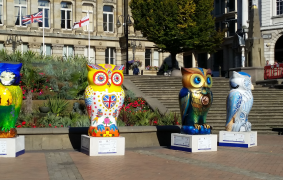
In the summer of 2015, Birmingham found itself home to 89 owls for the 'Big Hoot' public art trail, after which the statues were auctioned off to raise money for a Rare Disease Unit at the Birmingham Children's Hospital. To find out more about the recent trend for art trails and charity auction, often raising money for NHS children's hospitals,…
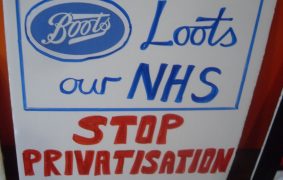
In the 1980s, when Leeds Hospital Alert was founded, many campaign groups became concerned by the privatisation of NHS services including cleaning and catering. This critique continues today, and underpins the work of the Keep Our NHS Public movement.
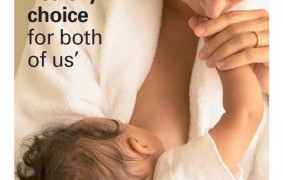
This poster was part of a wider public health campaign launched by the Department of Health aimed at encouraging new mothers to breastfeed. It emphasises the benefits of breastfeeding for both baby and mother and recommends finding out more from an NHS midwife or health visitor.
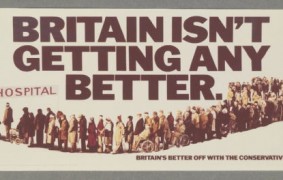
Both recognising and challenging the now-established public perception of affinity between the NHS and the Labour party, the Conservative Party fought the 1978-9 general election campaign in part by attacking Labour's claims to be the party best able to protect the NHS. This poster, and especially its more famous cousin 'Labour isn't working', would have enduring resonance.
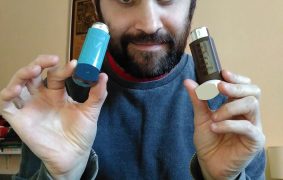
"My asthma went away for many years but came back when I moved to London (I think because of the Plane Trees and their fat pollen). I went to visit my GP (a husband and wife practice where the receptionist always asks if you want to see the Lady Doctor or the Man Doctor when you make an appointment) and…
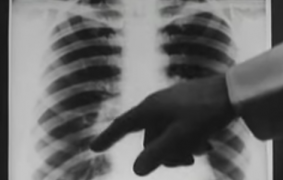
This was film was created by the Central Office of Information and outlines how tuberculosis can be diagnosed and the types of treatments available. The film follows two sisters as they are examined for tuberculosis, with one sister diagnosed with the disease and sent to a sanatorium for treatment. The narrative is framed in positive terms, encouraging viewers to avail…
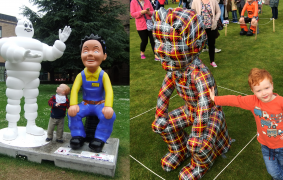
Over the summer of 2016, Oor Wullie's Bucket Trail saw 55 statues of the iconic Sunday Post comic strip character on display all over Dundee. In September, the statues were auctioned off to raise money for the ARCHIE Foundation’s charity appeal to support a new theatre suite at the Tayside Children’s Hospital. To find out more about the recent trend…
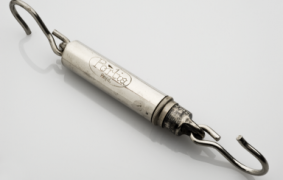
These scales were used in the early years of the NHS to weigh babies both in hospital and at home . They were usually accompanied by a strong net holder into which the baby was placed and uses a metal spring balance to take accurate weight measurements. It was simple to use and easy to transport and therefore was often…

Twenty years after the Wallace and Gromit Appeal for the Bristol Children's Hospital was set up, 'Shaun in the City' was their second city-wide art trail, following 'Gromit Unleashed' two years before. To find out more about the recent trend for art trails and charity auction, often raising money for NHS children's hospitals, click here.
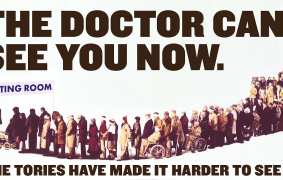
This poster, from Labour's 2015 national election campaign, consciously reminds readers of earlier Conservative posters, including the well-remembered 'Labour isn't working' poster of the first Thatcher campaign, but also the less familiar but even more similar 'Britain isn't getting better' poster of the same period. Interestingly, there is no evidence that this poster ever appeared in a physical format; it's…
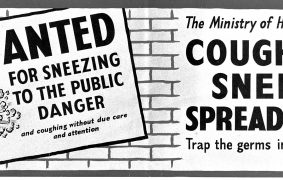
Produced by the Ministry of Health and the Central Council for Health Education in the late 1940s, this poster formed part of the second phase of the 'Coughs and Sneezes Spread Diseases' campaign that had been launched during the Second World War.
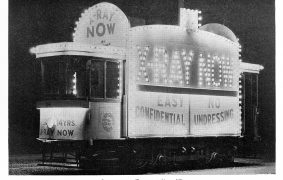
Despite reduced incidence of tuberculosis in England and Wales, Scotland, and in particular Glasgow, had been dogged by tuberculosis throughout the immediate postwar period. By the 1950s the Department of Health for Scotland was committed to reducing the incidence of the disease by creating an X-Ray campaign accompanied by a media 'blitz'. As part of Glasgow's X-Ray campaign against tuberculosis,…
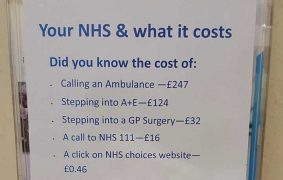
This is an image commonly found in NHS waiting rooms and depicts the idea of cost within the NHS. Even though the NHS is a free heath service in theory, the government still want people to be aware of the costs in practice. The idea of cost being thrown at patients constantly is interesting because it puts responsibility on patients…
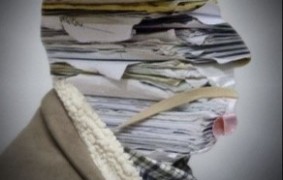
This artwork is titled ‘Depersonalisation in medicine (“(Mis)recognition”). It was produced by a project called 'Patient as Paper’, between an artist, Emma Barnard, and a clinical consultant and ear-nose-throat surgeon, Mike Papesch, in 2013. The artwork displays a concern that record-keeping reduces a patient to a collection of signs and symptoms and, in doing so, fails to capture the person…

Part of the same campaign as The Happy Smile, this poster outlines some top tips for keeping teeth and gums healthy. It is centred on what to eat, when to brush and the importance of regular dentist checks.
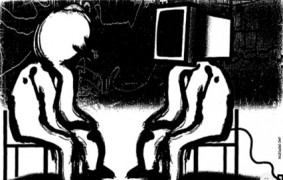
Developments in computing provided many benefits to clinicians and patients, but were also the cause of much concern. This cartoon accompanied an article in the Guardian, which stated that: ‘One fine day we’ll look round and find computers are making all our medical decisions for us, they’ll be sorting our medical notes, telling us when to come for our next…
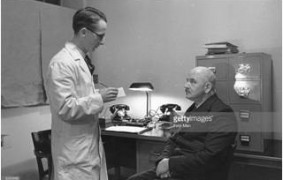
‘A General Practitioner writing a prescription for a patient in his consultation room’, Picture Post, 1941 (Getty Images).
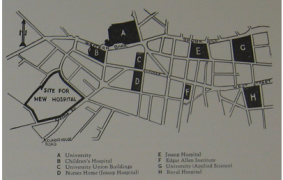
Featured in the Pre-NHS Healthcare Reforms gallery. Plans for a new university hospital in Sheffield to be funded by the city’s voluntary hospitals’ 1938 Million Pound Appeal.
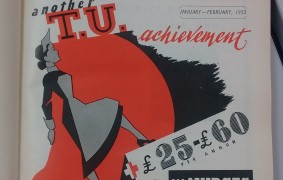
Cover of the National Union of Public Employees' Journal, January 1953. NUPE celebrate a pay rise negotiated for nurses in 1953.

Once again part of the second iteration of the wartime 'Coughs and Sneezes Spread Disease' campaign, this poster depicts a handkerchief blown away by a sneeze. It emphasises the need to catch any cough or sneeze so that germs are trapped and cannot be passed on.
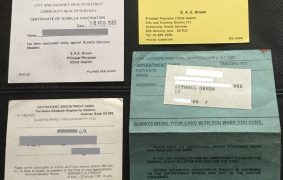
These cards record my wife's East London childhood in the NHS -- vaccinations, check ups, hospital appointments. Her mother saved them all, and gave them to her (with her birth certificate) when she left home in the late 1990. Not only was she immunised for TB (unlike most British kids today) but two of the cards instruct her to bring…
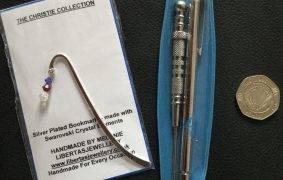
Once I started looking, the NHS was everywhere in my house - a charity bookmark made to raise funds for the Christie Hospital; a fifty-pence coin celebrating fifty years of universal, free-at-the-point-of-need NHS care; and the curious tool for NHS acupuncture and acupressure treatment (or maybe for 'sham' acupuncture? I am not quite sure!) given to me by the kind…

Cover of the National Union of Public Employees' Journal, 1952. NUPE celebrates a raise for NHS ancillary staff. Ancillary staff included all sorts of people who helped the service keep going like cleaners, cooks, porters, gardeners and many more.

In media coverage of the 60th anniversary of the NHS in 2008, Aneira Thomas was presented as the first baby to have been born in the NHS. It is interesting that a picture of Aneira as a young girl, rather than as a baby, accompanied these articles. This indicates that in the year of the opening of the NHS there…
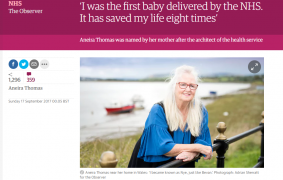
Aneira Thomas, the first baby born in the NHS, was interviewed for the Guardian in an article published on 17 September 2017. In the article, Thomas discusses how she felt about being a 'National Health baby' throughout her childhood, and her views on the NHS and its future today. That this interview was published shows enduring public interest in the…
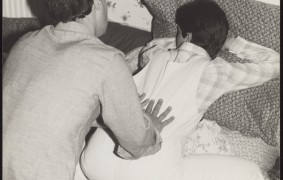
From the 1950s antenatal classes have been provided for prospective parents firstly through the National Childbirth Trust and later from the 1960s by the NHS itself. They remain popular for preparing parents for labour, birth and caring for their newborn child.
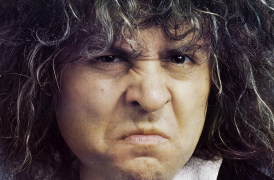
Health Education Council Anti-Smoking Poster, 1971-1975. (Science Museum, https://www.sciencemuseum.org.uk/broughttolife/objects/display.aspx?id=93448)

Anti-Smoking poster designed by graphic designer Reginald Mount for the Central Office of Information, 1965-1970 (Science Museum, https://www.sciencemuseum.org.uk/broughttolife/objects/display.aspx?id=93445)
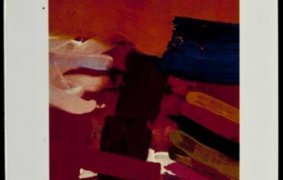
By 1989, 10 years after the ‘Art in Hospital’ scheme was established, the Fund had supported more than 40 projects – for a number of hospitals including Charing Cross, the Royal London, St George’s, St Stephen’s, The Royal Free and St Thomas’s – with around £20,000 a year invested in arts-related projects.
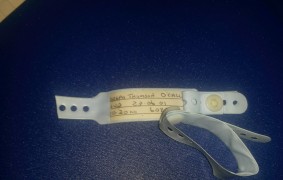
The tags attached around the ankles of new-born babies may provide one of the most significant forms of NHS personal memorabilia. In the past, the handwritten nature of tags emphasised the personal nature of these objects. Many parents have held on to baby tags. We would like to know more about the emergence of this practice, the changing nature of…
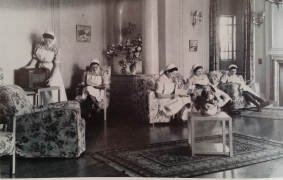
Prospectuses were keen to show the facilities for nursing students, such as the lounge in the preliminary training school at Saint Bartholomew's Hospital.
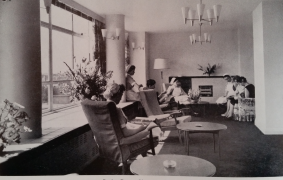
Prospectuses were keen to show the facilities for nursing students, such as the Sitting Room at Saint Bartholomew's Hospital's Gloucester House.
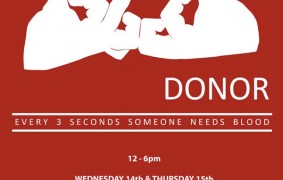
Featured in the Encouraging Blood Donation gallery. This poster was part of a targeted blood donation drive in Birmingham. It represents an important shift towards locally-targeted blood donation services to augment more infrequent national campaigns. The statistic that 'every 3 seconds someone needs blood' is a succinct and clear way to impart the message of the poster along with the…
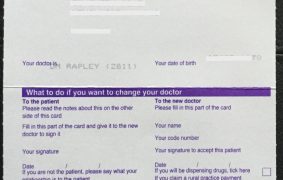
Coming from a country with no health service, I was thrilled to get my first NHS card -- I didn't really understand that I wouldn't need to carry it around or show it to NHS staff in order to be treated. Even now that I know I don't need to prove my right to use the NHS, I still treasure…
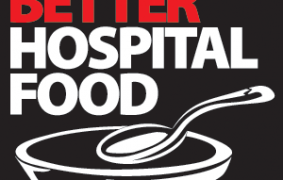
Publicity logo for this campaigning group established in 2012, that seeks to improve hospital food standards across the NHS as well as combatting food waste. (Logo from https://www.sustainweb.org/hospitalfood/)
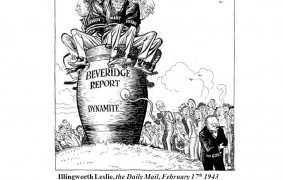
The 1942 Beveridge Report (named after its author, Liberal economist William Beveridge) famously argued for state intervention to do away with the 'Five Giants': squalor, ignorance, want, idleness, and disease. Received with considerable popular acclaim, the Report was also -- as cartoonist Charles Leslie Illingworth depicts here -- political dynamite. The explosive changes of the immediately post-war era can at…

This particular image of the generic blue curtain found across all hospitals within the UK was the first thing that came to mind when I thought of 'the NHS'. Any patient who has spent time in one of these perfectly aligned beds will not only remember its striking colour, but will also think about the senses and emotions mustered when…
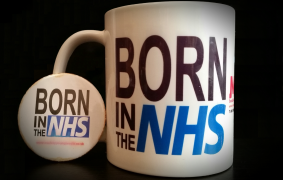
On 10 May 2013, writer Caitlin Moran tweeted ‘I am buying this “Born in the NHS” mug RT’. Response was rapid, with 154 retweets and many more mugs ordered. One respondent tweeted ‘Much embarrassed not to have been born in the NHS, especially when married to NHS midwife’.
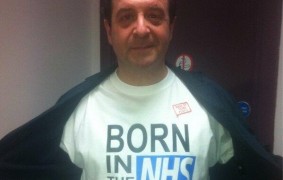
In 2013, comedian Mark Thomas, pictured here, had the idea of a ‘Born in the NHS’ slogan to accompany tee shirts and other goods produced by the social enterprise Made by Young People. We are interested in how and when being born in the NHS emerged as a symbol of personal support for the NHS.
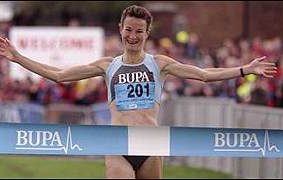
The branding of the NHS in the 1990s ran alongside the evolution of branding for the major private insurer of medicine, BUPA (the British United Provident Association). The two institutions have fascinatingly parallel histories. In fact BUPA was founded in 1947, a year before the opening of the NHS. The 1990s saw BUPA expanding from insurance to the provision of…
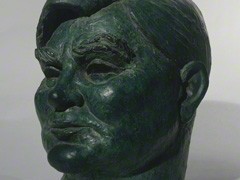
Peter Lambda was both a sculptor and a script-writer, working both in theatre and for the Crown Film Unit during the Second World War producing propaganda films for the BBC. he son of a doctor and a psychoanalyst, Lambda trained in medicine before turning to sculpting as his career. Following a meeting with Bevan in 1945, this bust was commissioned…
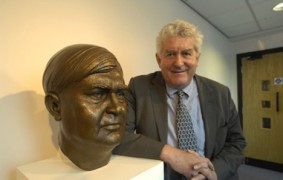
A bronze bust of Nye Bevan by Robert Thomas. This photo is taken with First Minister Rhodri Morgan, who unveiled the bust to be on display at the Aneurin Bevan building, at the University of Glamorgan’s Faculty of Health, Sport and Science, 'to inspire Wales’ nurses and health care workers of the future'.
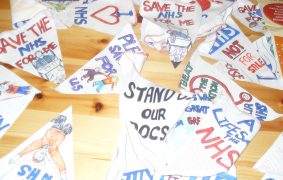
Bunting produced by Leeds Hospital Alert for protests, showing a variety of themes and concerns about the future of the NHS. The designs are very detailed, and painstakingly created, symbolic of the dedication and passion felt by members of this group.

Irish athlete, Sonia O'Sullivan, winning the Great North Run in 1998.
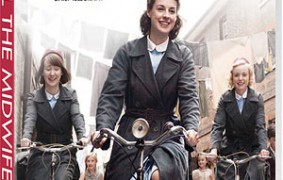
A new BBC television series ‘Call the Midwife’ launched in 2012. With further series in 2013, 2014, and 2015, 'Call the Midwife' has proved hugely successful. It centred on the drama of giving birth in the early days of the NHS, before the days of hospitals becoming central. Its popularity raises interesting questions about the way that our feelings about…
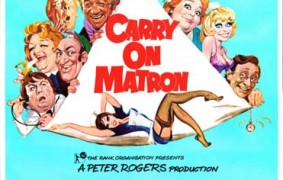
Publicity poster for Carry on Matron (1972) set in Finisham Maternity Hospital. This was the 23rd film in the Carry On franchise and the fourth with a medical setting. Though the franchise was on the wane by the 1970s, these remained highly popular films. The film offers us a picture of birth in hospital becoming an increasing norm.
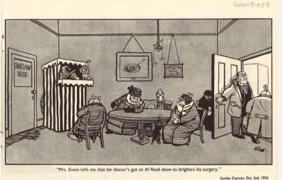
This cartoon portrays the GP surgery as a dingy, dark and unattractively decorated space. It states: ‘Mrs Evans tells me that her doctor’s got an Al Read show [popular radio comedian] to brighten his surgery’. (Ronald Carl Giles, Sunday Express, 3 October 1954, in British Cartoon Archive).
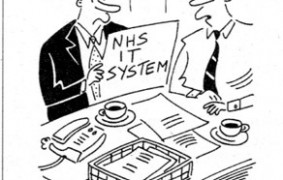
This cartoon is about the National Programme for IT, which was an ambitious £12bn programme to digitise the NHS. Amongst other measures, the programme was intended to introduce a single electronic record for every patient, which could be shared across and accessed by primary, secondary and social care settings. The cartoon was drawn whilst the programme was being dismantled in…
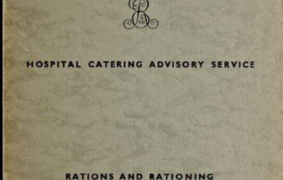
After the National Health Service was established in 1948, The King’s Fund set up several schemes to provide advice to hospitals, including the Hospital Catering Advisory Service. Advice included this document on how to make the most of rationed commodities after World War II
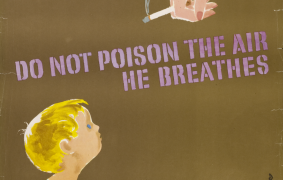
Central Council for Health Education Poster aimed at discouraging smoking around children c. 1960s (Science Museum, https://www.sciencemuseum.org.uk/broughttolife/objects/display.aspx?id=93446)
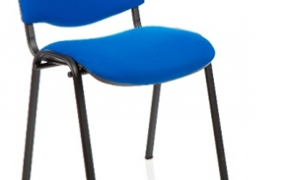
This is a vinyl stacking chair which is used in NHS waiting rooms. This object was an everyday symbol of the NHS for us, as it representative of a situation that most, if not all, members of the British public have experienced – sitting in an NHS waiting room for a GP or hospital appointment. In this space, a collection…
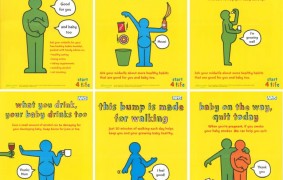
Change for Life Poster (Available in print and via https://www.nhs.uk/change4life).
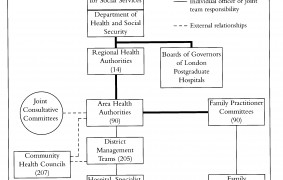
One of Charles Webster's many diagrams for his official history of the NHS, this chart documents the dramatic changes to the Service implemented in 1974.

Child's spectacles frame, British ca. 1950s. V&A Museum of Childhood. Museum no. B.303-1996

Sheila Dillon of BBC Radio 4's Food Programme explored the food stories of Britons who won't be at home with their families on Christmas Day. It includes an interview with Martin McLachlan, the Imperial NHS Trust Facilities Manager examining how Christmas dinner is provided within the Trust's five NHS hospitals. The episode also includes first-hand memories of Christmas day on…
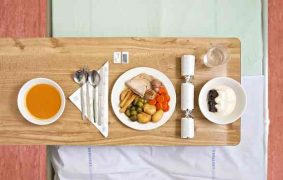
Christmas celebrations are intimately linked with food -- but can hospitals provide a traditional Christmas dinner that satisfies patients, nutritionists and managers alike?
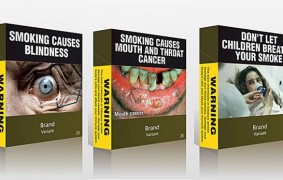
Health warnings were first introduced in 1971 and from 2008 pictorial warnings have been included. (Generic packaging from a blog which is no longer available when checked on 19th September 2025)
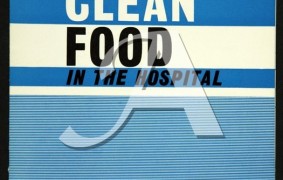
Hospital Food in the Hospital Leaflet produced between 1948 and 1963 (The National Archives, https://images.nationalarchives.gov.uk/assetbank-nationalarchives/action/viewAsset?id=13136&index=0&total=1&view=viewSearchItem
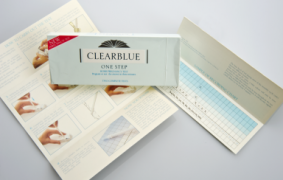
From the late 1980s, easy to use at home pregnancy tests became an increasingly common way for mums-to-be to confirm their pregnancy before they reached out to their GP for confirmation. The availability of such tests altered where pregnancy was confirmed and when women chose to access maternity care through the NHS. They represented an important way in which scientific…
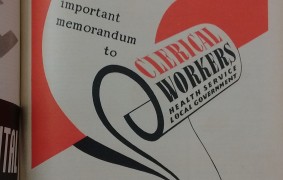
Cover of the National Union of Public Employees' Journal, 1950. NUPE looked to recruit "clerks" (what we would now call administrators) in the health service and local government.
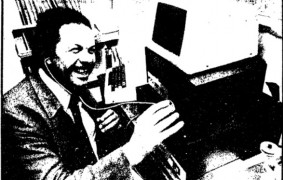
In the late-1970s, clinicians developed computers which could automatically ask patients for basic information, and provide patients with answers and even with psychotherapy. One such programme was called Mickie (Medical Interviewing Computer in Ermintrude), and was used at the Fulham general practice of Dr Geoffrey Dove (pictured above). The Guardian reported that Dove 'doesn't see the device demeaning his job,…
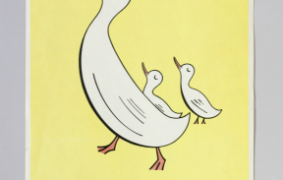
This poster was produced by The Stroke Association and used bright visual imagery to encourage take-up of mass miniature X-Ray programmes in the immediate postwar years. Its central visual image, comprised of mother goose and her three goslings, contributes to a wider postwar preoccupation within health education that used images of children with their parents alongside suggestive text to encourage…
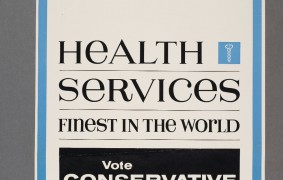
Support for the NHS was, at least rhetorically, a matter of party political consensus in the 1950s and 1960s - though in practice funding and provision changed significantly from the initial promises of the 1940s.
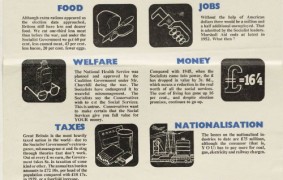
Having learned the lessons of the narrowly lost 1950 general election, the Conservatives included their own proprietary claims to the NHS in 1951 election leaflets. The text here reads, in part, 'The National Health Service was planned and approved by the Coalition Government under Mr Churchill during the war. The Socialists have endangered it by their wasteful mismanagement.'
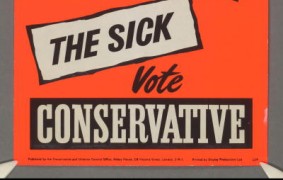
Continuing the health themes of the 1951 election, this 1955 General Election poster for the British Conservative Party offers 'More for the young, the old, the sick. Vote Conservative'.
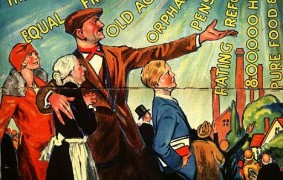
Capturing the importance of health as a trope in political campaigns and debates, this Conservative Party election poster presents the Party and its policies as themselves therapeutic to the British body politic by likening them to a recent development in medicine: light therapy.
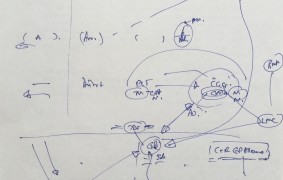
This organisational chart, sketched by a consultant while explaining the new post-2012 NHS to the People's History team, represents one practitioner's view of the complicated flows of power and responsibility in the health services.
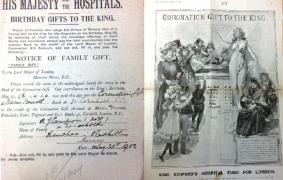
When Queen Victoria died, the Prince of Wales became King and the Fund became known as King Edward's Hospital Fund for London. The £18,663 raised as a coronation gift for the new King was donated to the Fund, ensuring that the Fund could continue its work in supporting voluntary hospitals. The form here shows one way of contributing to the…
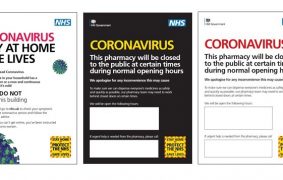
A selection of Coronavirus posters created by Public Health England in April 2020
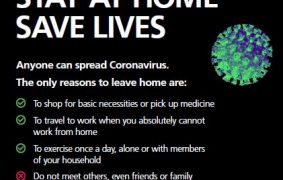
Produced rapidly by Public Health England for the NHS, this poster forms a part of a larger corpus of posters, available digitally, which implore the public to stay at home for all but essential reasons. Its central message of 'Stay at home, Save Lives' was an important mantra repeated by government officials throughout the national lockdown and circulated vigorously through…
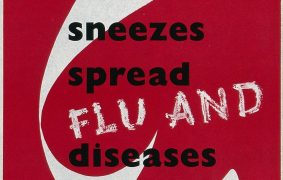
This poster reflected the first major alteration of the 'coughs and sneezes' campaigning message. Its inclusion of 'flu' reflected the increased circulation of H1N1 in the winter of 1951 and this message was circulated again during the Avian Flu pandemic of 1957. The addition of flu to an already well-known slogan showcased how similar the prevention methods were for both…
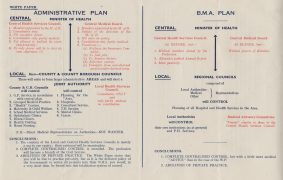
A document outlining the proposed changes to healthcare in Britain, published by The Counties Practitioners’ Group When plans for the NHS were being proposed, some physicians believed that the plans were a direct threat to their livelihood. This document, issued by a group of doctors including physicians, outlines the key points of both the Governments White paper and the British…
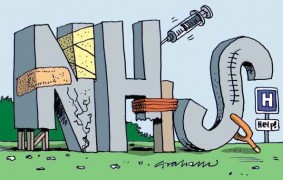
The Labour Party had struggled to find an easy symbol to represent the NHS when they were critiquing spending in the 1980s. The adoption of a logo in the 1990s provided a symbol not just for the branding of the service itself but for campaigners critiquing changes to and under-spending on the service. In this Graham cartoon, the initials serve…
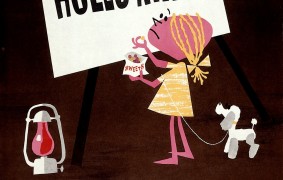
This poster, from 1960, was designed by Reginald Mount, a graphic designer who worked closely with the Central Office of Information. It emphasised the role 'soft sweet sticky things' played in causing tooth decay.
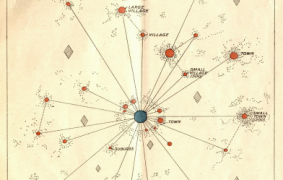
Featured in the Pre-NHS Healthcare Reforms gallery. One of the first acts of the new Ministry of Health, set up in 1919, was to commission a report from a committee chaired by Lord Dawson on how to organise modern medical services. The report recommended a network of regional and district hospitals and smaller health centres across the country.
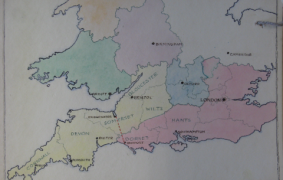
Featured in the Pre-NHS Healthcare Reforms gallery. During the Second World War, the Ministry of Health and the Nuffield Trust worked together to survey the hospital services and needs across the country, leading to debate about where regional boundaries should be drawn.
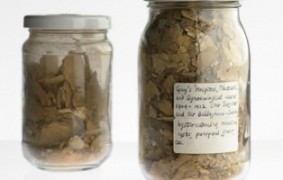
This artwork was produced in the 1980s, and collects the powder produced from the decay of Guy’s Hospital medical records. The image suggests the vulnerability of paper records - although electronic records, too, may be destroyed as technologies change, or if tampered with by external hackers.
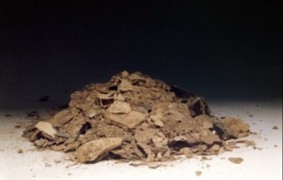
This artwork was produced in the 1980s, and collects the powder produced from the decay of Guy’s Hospital medical records. The image suggests the vulnerability of paper records - although electronic records, too, may be destroyed as technologies change, or if tampered with by external hackers.

In this march to save defend the Whittington Hospital's Accident and Emergency service from closure in 2010, the black cat rather than the NHS logo took centre stage. This indicates the ongoing importance of local identities within the NHS.
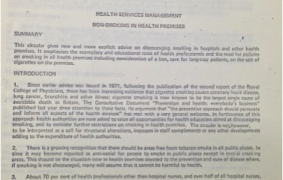
Department of Health Circular (HC(77)3): Non-Smoking in Health Premises, 1977 (Photographed by Jane Hand from an original in The National Archives)
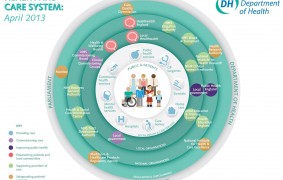
This diagram, created by the Department of Health, suggests that patients are at the heart of the newly restructured health services. It offers little information about decision-making or power dynamics in the new NHS, post 2012.

Some campaign placards directly address specific MPs - such as this one aimed at Frank Dobson during his time as Secretary of State for Health (1997-1999).
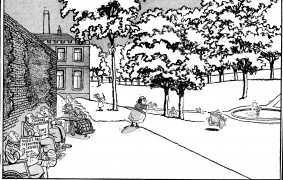
This cartoon from 1971 marks a change from the more regular depiction of nurses as ministering angels. In fact lots of Giles' cartoons from this period show nurses in combative mood, asserting themselves in interactions with unruly patients. Here one nurse, having been criticised by a patient, shoves him down the hill and into a pond. The newspapers clutched by…
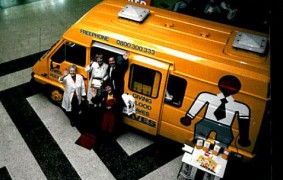
Featured in the Encouraging Blood Donation gallery. Maintaining adequate supplies of blood was always a continuing challenge for the Blood Transfusion Service, the body responsible for collecting and supplying blood to the NHS. Following a name change to the National Blood Service, there was a greater effort to use mobile donation clinics to encourage people to give blood during well-advertised…
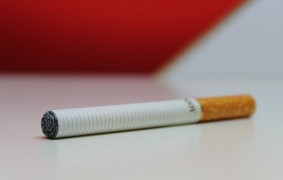
The e-cigarette has forged a prominent place in the twenty-first century smoking landscape with the massive rise in popularity of 'vaping'. (Photo credit: Lindsay Fox via https://blogs.lshtm.ac.uk/news/2014/07/11/electronic-cigarettes-history/)
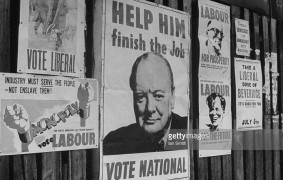
In the long (indeed, prolonged so that servicemen overseas could cast their postal ballots) election of 1945, the welfare of the British public was a key issue. While the Conservatives sought to capitalise on the achievements of wartime leader Winston Churchill, both Labour and the Liberal parties presented visions of a future in which resources and welfare would be more…
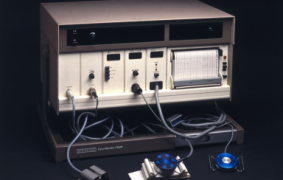
During childbirth the baby's heart rate and the mother's contractions are constantly monitored using machines like these. Changes in the foetal heart rate often lead to medical intervention. They have become commonplace features of hospital births in the NHS since the 1970s.
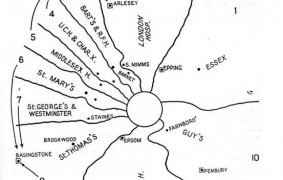
Featured in the Pre-NHS Healthcare Reforms gallery. The wartime Emergency Medical Service introduced a new level of regional organisation.

Epidurals have become increasingly common forms of pain relief during labour. They were made available for this purpose from the 1960s and today NHS maternity wards offer epidurals to women routinely to help relieve the pain of contractions.
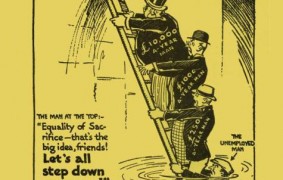
Based on a 1929 cartoon by J. F. Horrabin, this poster explicitly critiqued the greater impact of the National Government's 'Equality of Sacrifice' on the poor.
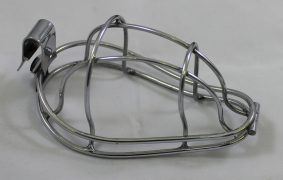
This mask was used by Doctors in the early years of the NHS. It is one part of a larger anaesthesia kit used for house calls to patients. A cloth rag would be placed over the metal wire, designed to keep the ether, which could cause irritation, away from a patient’s skin. Accession number 2018.7.7
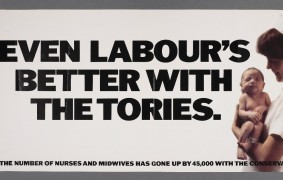
After the turbulence and medical activism of the 1970s, the Conservatives felt they were well-positioned to challenge Labour Party claims about the NHS in the 1978/9 general election.
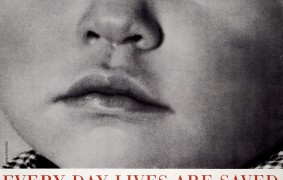
Featured in the Encouraging Blood Donation gallery. This poster was designed by Reginald Mount and Eileen Evans for the Ministry of Health. Building on their previous work on blood donation poster creation, this poster continues to use the child as the central visual image. With this poster however, a close-up on one child's face, divorced from a hospital location or…
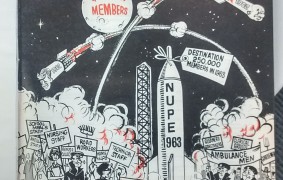
Cover of the National Union of Public Employees' Journal, January 1963. NUPE saw itself as the union for everybody who worked for the NHS or local government and this cover depicts many of the groups they looked to recruit from: nurses, technical workers, ambulance drivers, cleaners, ancillary workers and clerks.
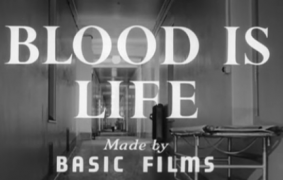
Featured in the Encouraging Blood Donation gallery. Blood is Life shows the work of the National Blood Transfusion Board in the late 1950s. It shows men and women responding to the call to give blood and shows the process of blood donation and blood transfusion. It emphasises the importance of maintaining equipment and keeping records as well as how blood…
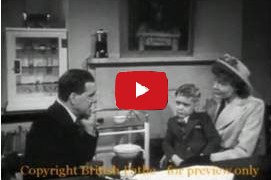
Choose Your Doctor (1948) film from the Ministry of Information (British Pathe, hosted by youtube).
Featured in the Pre-NHS Healthcare Reforms gallery. In 1913 the Highlands and Islands Medical Service was set up, bringing the most advance health services to the remotest areas of the UK. 7 minutes in to this short film two doctors begin discussing the virtues of the scheme.
Featured in the Pre-NHS Healthcare Reforms gallery. This film depicts the pioneering work of the Peckham Health Centre, an independent voluntary community initiative first opened in 1926 and moving to this purpose-built centre in 1935.
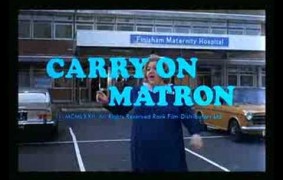
Matron, played by Hattie Jacques, stands in front of ‘Finisham’ Maternity Hospital at the opening of Carry on Matron (1972). Interior shooting took place at Pinewood Studios. Heatherwood Hospital in Berkshire provided the location for the exterior shots of Finisham. Founded in 1922, Heatherwood was taken over by the NHS as a general hospital. Its birth unit closed in 2011…

Page from the first annual report of the King’s Fund published in February 1898. This page shows the original council, with the then Prince of Wales as President and others on the board at the time.
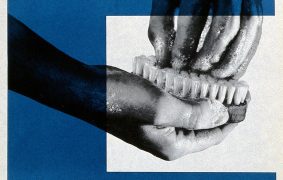
Focused on hand washing to prevent food poisoning, this poster visually depicts the act of hand washing. The inclusion of a nail brush visually highlights the importance of cleaning well under nails so as to fully prevent the contamination of foodstuffs from unhygienic handling.
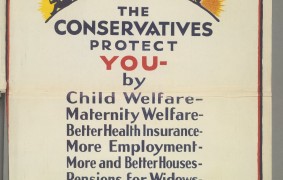
Conservative Party Election Poster, 1929 The 1929 General Election, also known as the 'Flapper Election' was the first in which women were allowed to vote on equal terms as men -- that is, all men and women over the age of 21 were enfranchised. As in 1918, this prompted both political parties to make strong claims and promises about improvements…
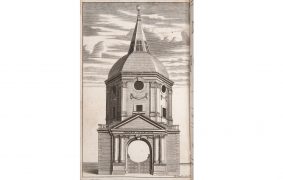
In 1687 the Royal College of Physicians announced that its members would give free treatment to paupers and proposed the building of a public dispensary based at the College, where the poor could receive free medicines. This angered the Royal Society of Apothecaries who were angered by what they saw as a direct threat to their livelihood, and there was…
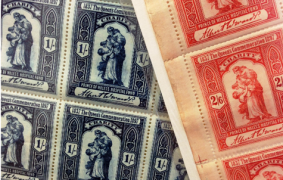
This series of postage stamps was produced by The King’s Fund as part of ‘The Hospitals of London Combined Appeal’. They date from between 1897 and 1922, with each stamp depicting the crest of one of the London hospitals supported by the Fund.The stamps were sold by London schoolchildren, raising approximately £15,000 (around £640,335 today’ to help fund the work…
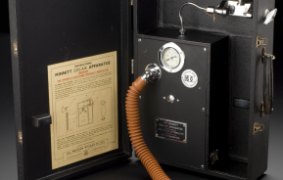
The first gas and air machine used as a form of pain relief in labour was developed in 1935. They grew in popularity after the Second World War, and in particular during the first two decades of the NHS. They allow mothers to self-administer the mixture of nitrous oxide and air and remain a popular form of labour pain relief…
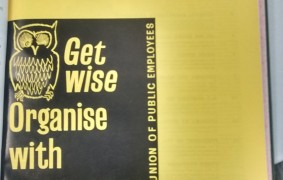
Cover of the National Union of Public Employees' Journal, 1963. NUPE re-launched their journal in 1963, hoping to look more modern. The NUPE "get wise" owl also featured in their other recruitment material like posters and leaflets.
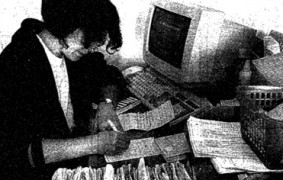
This image accompanied an article in the Guardian which wrote that 'computerisation in the NHS has has [sic] often failed to provide efficiency or savings'; a challenge which is still made today, by some, with regards to the digitisation of patient records.

GPs can view far more patient information than patients themselves can. This raises important questions about who owns patient data, and who should decide how much information patients, their families, and clinicians can access.
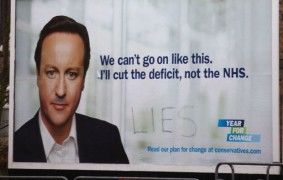
Voters are no more friendly to Conservative Party claims, as the graffiti on this 2010 billboard suggests.
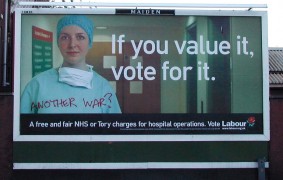
Voters have become used to - and cynical of - party political claims about the NHS. Here, a defaced Labour Party billboard from 2005 illustrates voter disillusionment.
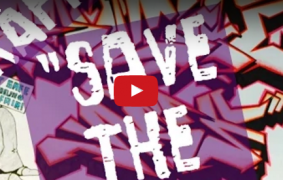
"I have Bone Cancer, a paint brush & some cameras..." As part of vlogging (video blogging) both his experience of cancer and his artwork, the artist known as PommyT87 posted this video on YouTube on 5 November 2015 with the message: "7 months ago I won Man of the Match in a charity football match at Ewood Park. Today I…
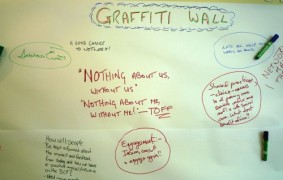
'Graffiti walls', such as this one from Thurrock in Essex, have been one way in which the NHS has sought to bring very public feedback and discussion into the spaces used by staff and patients. There is often a tendency for counter cultures to be co-opted, but the official use of 'graffiti walls' is at best a rather superficial effort…
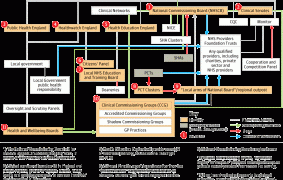
This chart, produced by the Guardian newspaper to reflect Labour Party critiques of the 2012 Health and Social Care Act, highlights the complexity of the structural reforms it demanded. Cluttered with lines and arrows, the diagram presents the new system without any reference to patients, or any place for users' voices to feed into its management.

Prospectuses were keen to show the facilities for nursing students, such as this Nurses' Sitting Room at Guy's Hospital.
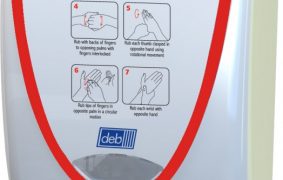
My image is of a hand sanitizer dispenser. I picked this image because everytime I go to my doctor or to a hospital they seem to be everywhere. I can't go into a doctors surgery or a hospital without using more hand sanitizer than I could possibly ever need. It's kind of become almost a reflex action to use one…

The Jewish festival of Hanukkah, which often falls close to Christmas, attracts less media attention. But it too is celebrated in the NHS and in private health and social care establishments with Jewish users and clients. Here, a school girl is pictured with the Hanukkah sculpture ( a Chanukiah) she designed for one of Jewish Care's health campuses in Golder's…
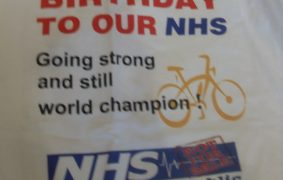
The idea of celebrating the 'birth' of the NHS is a repeated feature in modern NHS campaigning. Leeds Hospital Alert and many other groups held celebrations around the 60th 'birthday' in 2008. We'd love to see even older examples of such campaigning, if anyone has some to share? If so please email them to NHSEngage@warwick.ac.uk.
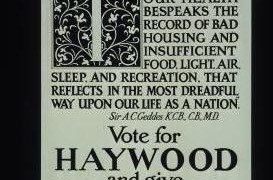
Labour Party Political Poster c. 1910s-1930s Transcription: "Health. The record of our health bespeaks the record of bad housing and insufficient food, light, air, sleep, and recreation, that reflects in the most dreadful way upon our life as a nation."--A.C. Geddes. Vote for Haywood and give Labour a chance!"
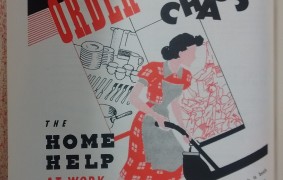
Cover of the National Union of Public Employees' Journal, 1950. As a union covering the NHS and local government, NUPE crossed the boundary between social care and health care, recruiting the "home helps" (care workers) sent to help the aged and people with disabilities.
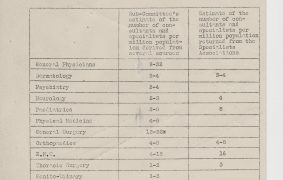
Document estimating the number of consultants and specialists required per million of the population, c.1944-48 This document is an appendix item to a larger document entitled the Royal College of Physicians Consultant Services Committee Second Interim Report. The RCP published many documents like this, demonstrating the detailed planning that had to go into the formation of a service like the…
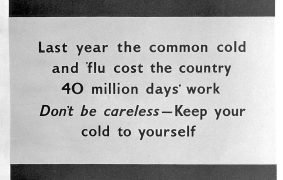
This black and white poster outlines the economic consequences of lost work days due to the spread of cold viruses in the community. It lays the blame with the individual and calls on the public to not be careless when it comes to stopping 'coughs and sneezes'.
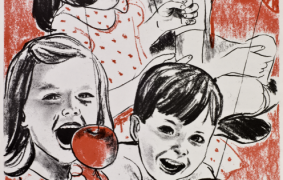
This poster was produced by the Central Council for Health Education in the early 1960s and coincided with the Ministry of Health's own dental health campaign. It suggested fruit and salad as healthy snack alternative for children to help keep their teeth strong, while re-asserting the importance of daily brushing.
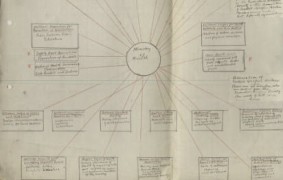
This image, created by the Industrial Health Education Society in 1924, shows the complex patchwork of health provision in relation to the Ministry of Health before the NHS. See the whole image and its text at the Modern Records Centre
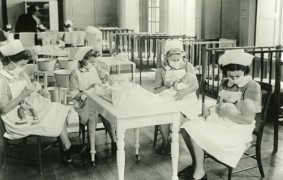
Infant feeding in Hospital Nursery (Image via https://www.hiddenlives.org.uk/blog/2013).

The NHS logo has gained not just national but international recognition. In April 2015 Islamic State released a video on social media that appears to have borrowed heavily from the NHS branding in promoting their own health service. Such brand recognition for the NHS and its logo has encouraged the idea of selling its services overseas.
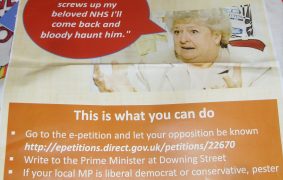
This flyer includes practical recommendations on how best to oppose the 2012 Health and Social Care Act; through familiar tactics such as writing to MPs, but also with the relatively new medium of the e-petition. Launched by Downing Street in 2006, the e-petition website often features requests about NHS care - sometimes inspired by individual or local cases, other times…
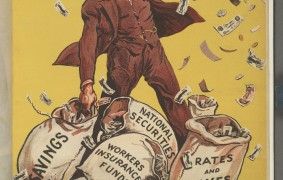
Conservative/National Party Election Poster, 1931 As the Labour Party gained in electoral power, the Conservative Party responded by presenting its policies as economically and financially reckless, and politically dangerous. 'Socialist' expansions in welfare provision were seen as especially vulnerable to such charges.
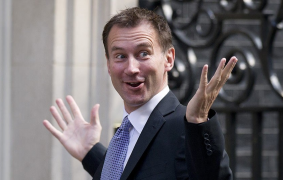
I thought of Jeremy Hunt because of my personal interest in following politics. I believe it is interesting how the political discourse relates to people's individual experiences/ beliefs regarding the NHS i.e If labour had argued for the need to restructure mental health care or enforced a pay cap how would these have been received by public/ doctors? Daniel Brennan
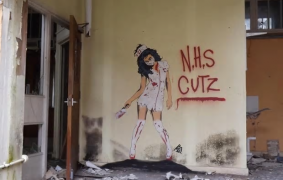
Street art flourishes in abandoned urban spaces, and abandoned mental hospitals around the world have proved sites for some unsettling work. The artist JPS typically works with silly puns, although there is a more serious if sardonic feel to his 'NHS CUTZ' in the abandoned Barrow Gurney mental hospital in Somerset.
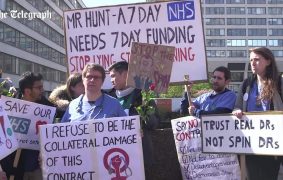
This image of the junior doctors strike depicts the anger and emotion felt towards the policies of Jeremy Hunt and the dismantling of the NHS. The emotive language used in the strike against Hunt suggests that it is strongly felt that the NHS should belong to communities rather than politicians. Dora Willcock
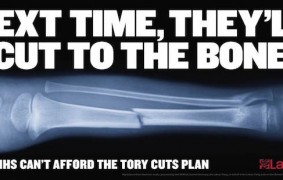
A key theme of the 2015 general elections was the precarious state of the NHS, for which the Labour Party outspokenly blamed the austerity-driven cuts of the Conservative led Coalition Government.

Labour's posters for the 1950 General Election drew attention to the Party's role in establishing the NHS, and thus improving the health of women, children and the elderly, who had not been covered by pre-war state provision.
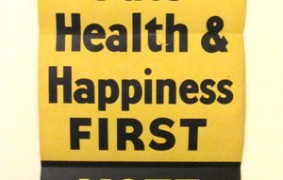
Labour Party Political Poster 1938 This was also the title of an election leaflet, extolling Labour's welfare credentials and agenda.
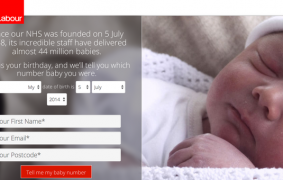
The Labour party launched this website in 2014. The calculation was that 97% of those born in Britain since 1948 had been delivered by the NHS. This indicates the relatively minor role of private health care across the period, though this remained the choice of many of the wealthy and famous. It was also an appeal that failed to address…
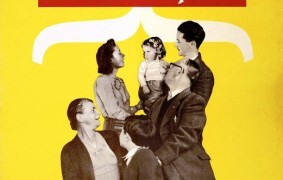
This famous poster (revived as recently as the 2015 General Election, when the Labour Party Shop re-fashioned it as a tea towel - which immediately sold out) demonstrates the party's sense that the NHS was already an popular emblem of post-war values, and a natural vote-winner. While the party lost the election, it won 48.8% of the popular vote, more…
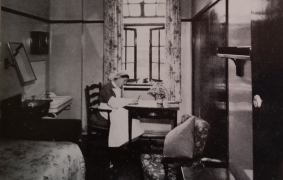
A nurse's bedroom, as shown in the prospectus for the Training School for Nurses at the Liverpool Royal Infirmary.
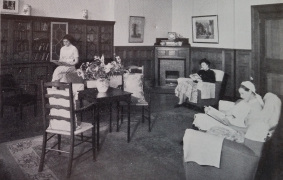
A nursing school prospectus would often show off duty nurses in the library, such as this one for the Training School for Nurses at the Liverpool Royal Infirmary.
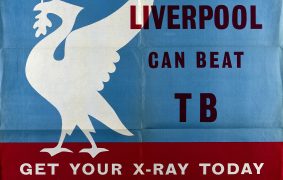
This poster was part of a wider anti-tuberculosis campaign launched in Liverpool in 1959 and spearheaded by Liverpool Medical Officer for Health, Andrew Semple. Requisitioning mobile screening units from around the country, Semple urged every resident to attend a unit for a chest x-ray, supported by house-to-house leaflet drops and the assistance of the local press. This poster reinforces the…
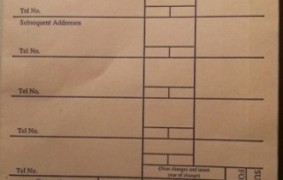
Lloyd George envelopes were first used in 1911, when the politician David Lloyd George introduced a national health insurance scheme for low-paid working men. The envelopes are still used today and provide a tangible reminder that there are continuities, as well as changes, in the provision of health and care over time.
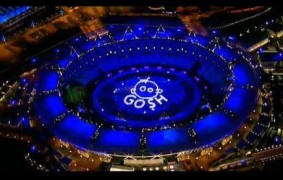
The opening ceremony of the London 2012 Olympic Games, directed by Danny Boyle, included a homage to Britain's NHS. However this focused on a more local site: London's Great Ormond Street Hospital for Children and its beds, nurses, and child patients. Although the letters NHS would be lit up for the international television audience, the lights also projected the Great…
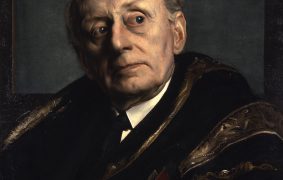
Portrait of Charles McMoran Wilson, 1st baron Moran by Pietro Annigoni, 1951 Lord Moran (1882 – 1977) was president of the Royal College of Physicians from 1941 until 1950 and served as personal physician to Prime Minister Sir Winston Churchill during the Second World War. He was a key figure in the foundation of the National Health Service. Accession number…

Photograph of a ward mealtime from the Ashford Hospital Archive, c. 1960s (Image rights: https://www.johnathersuch.com/ASHFORD_HOSP/pictures.htm)

Cover of the National Union of Public Employees' Journal, November 1949. NUPE celebrated Christmas in 1949 by bringing the gift of better pay and conditions in the NHS and local government to members and non-members alike.

This model of an MMR Unit created by the Science Museum to illustrate the interior of a mobile van and to show how the x-ray was taken. It displays women operators in white uniforms and a small queue of men wearing shirts to emphasise that there was no need to undress for the x-ray to be taken. This tells us…

Labour Party Political Poster in circulation from 1918, the first election in which women (at least those over the age of 30) were able to vote. Both parties strongly targeted these new voters -- often specifically as 'mothers' -- and both sought to attract them through making promises to improve the health and welfare of infants, children and women themselves.
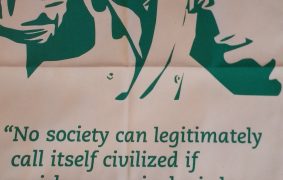
"Favourite Xmas present of 2016. Heartfelt reminders of the real value of the NHS"

Featured in the Pre-NHS Healthcare Reforms gallery. Lloyd George introduced National Insurance in 1911, providing cash benefits in times of sickness and access to a doctor chosen from a local panel for what grew to become the majority of working people by the 1930s. Contributions by employees were recognised with stamps and matched by both employers and the government.

A picture of this mug was provided to us by a member, who explained that NHS Contact was the first national email system for NHS staff. Staff were given this mug when it was first introduced, and our member still has it today!
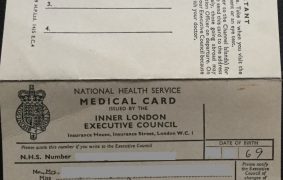
My partner's earliest medical card, issued in London in the very early 1970s. Looking at it again next to today's medical card, we were struck to see the instruction to BRING the card along to any medical appointment. Pretty interesting, given current debates about whether i.d. should be required when patients attend hospital appointments!

This e-card was created by an NHS clinical commissioning group to communicate with its service users at Christmas time.
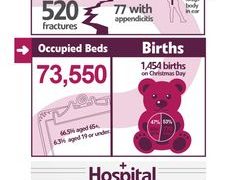
Would you say 'Thank you' to NHS staff or be especially grateful for the health services over Christmas? We are very interested in gift giving and gratitude in the NHS. You can read our blog and try our survey here: https://peopleshistorynhs.org/survey-gift-giving-in-the-nhs/
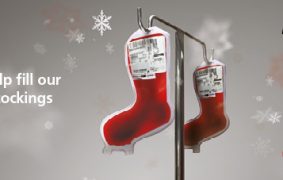
This 2016 campaign image, from NHS Blood and Transplant, reflects a long tradition of encouraging blood and organ donation as a 'gift' well-suited to a season of giving. Have you given a gift -- or received one -- in the NHS? Please take our gift-giving survey here!
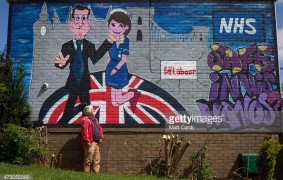
Ahead of the 2015 general election, Tony Davis commissioned a pro-NHS, anti-Tory mural for the side of his house. In a nod to Margaret Thatcher's reassurance that the NHS was 'safe in our hands', it asks if it is safe in those of Prime Minister David Cameron. Davis was instructed by the local (Conservative-run South Gloucestershire) council to remove the…
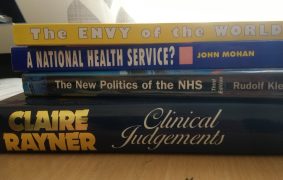
A mixture of NHS-related books from Jenny's shelf, demonstrating the ways in which stories about the NHS have pervaded political literature, romantic fiction, and poetry, since the institution's inception in 1948.
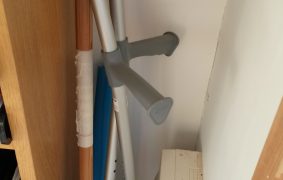
These NHS crutches have been hidden in this neglected area of my house for ages. I suppose they should have been given back. They were never asked for. They made a big difference in helping me to move around in those six weeks. I wasn't shown how to use them but was soon rather proud of my new proficiency. The…
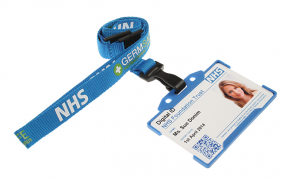
Signifies the staff, doctors and administrative staff of the NHS. These people are the face of the NHS. Shared uniform and identity. ID bagde makes it less personal- more formal. Dan Parker, Rhiannon Hall

The NHS logo would come to adorn an increasing range of signs and objects. We are interested in how such branding was experienced by staff and patients. We are also keen to establish the extent to which this was a new phenomenon. Preliminary analysis of earlier images of NHS settings suggests a striking absence of any such logos. What does…
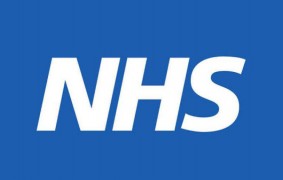
The NHS blue lozenge logo began to be used at the start of the 1990s, however new branding guidelines in 1999 ensured that it became widespread, strictly uniform, and universally recognised. The colour of the background has to be blue pantone 300. The letters have to be 2.4 times as wide as high. The letters have to be in Frutiger…
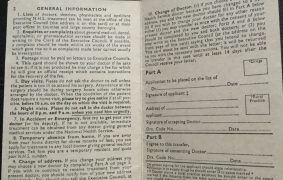
Although there are lots of similarities, there are differences, too, in what the instructions to patients on this 1970s medical card tell us about the NHS.
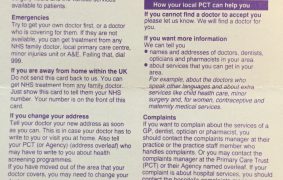
Interesting to see the similarities and differences between the 1970s medical card and todays... even the bits of NHS paperwork that float around our homes tell stories about the changing meanings of the NHS.
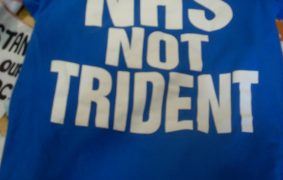
This t-shirt, collected by Leeds Hospital Alert, represents a long-standing comparison between the government spend on nuclear weaponry and the NHS. The medical peace movement dates back as far as the foundation of the Medical Association for the Prevention of War (MAPW) in 1951, and the Medical Campaign Against Nuclear Weapons (MCANW), founded in 1982. These groups were primarily composed…
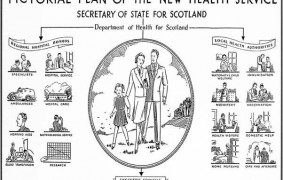
The Department of Health for Scotland created this organisational chart for public consumption in 1948, as a way to help familiarise people with their new NHS.
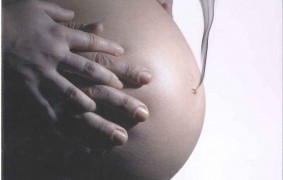
Controversial NHS Smoke Free Poster, c.2011(Image via www.hp.somerset.nhs.uk)
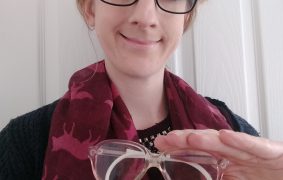
Our researcher Jenny Crane holds her first pair of NHS glasses, prescribed when she was just two years old! The frames she wears today are of a relatively similar style; though they are no longer provided for by the NHS.

This Welsh language online advent calendar offers tips about how to stay healthy at Christmas. You can explore it (and English language translations) here: https://www.wales.nhs.uk/sitesplus/862/page/64268
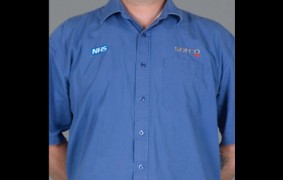
Uniforms also came to be branded with the NHS logo. Such an exercise could have benefits in terms of economies of scale but also identification. There were strict guidelines on the placement of the logo. Interestingly, this uniform is also branded with the logo of the private company Serco. The NHS logo had been developed in part to distinguish the…
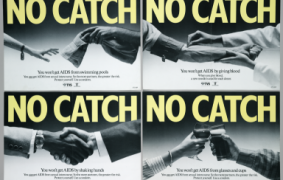
Featured in the Encouraging Blood Donation gallery. AIDS as a public health threat first emerged in 1981 and for many years there was considerable public confusion over how the disease spreads. It can be spread through unprotected sex, via contaminated blood products and by sharing needles. This poster aimed at educating people that AIDS can not be spread in swimming…
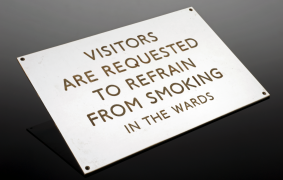
Notice from Frenchay Hospital, Bristol, England, 1960s (Science Museum, https://www.sciencemuseum.org.uk/broughttolife/objects/display.aspx?id=5061)
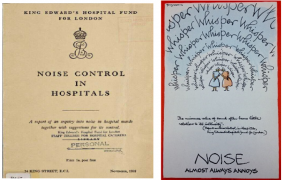
This 1958 report, depicted noise as a thoroughly modern malaise: 'that the world is growing noisier is obvious to us all; towns, roads, buildings and even hospitals are all noisier than ever before’. In the surveys used for the report, patients often cited hospital equipment as a cause of noise on wards, with metal trays rattling on trolleys, squeaking trolley…
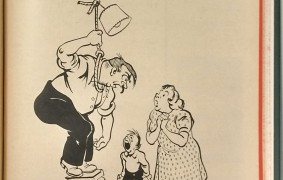
Cover of the National Union of Public Employees' Journal, 1951. This back cover depicts in extremely graphic terms NUPE's attitude towards "nons" (non-union members) in local government and the health service. In 1951 NUPE negotiated terms and conditions for hospital workers on what were called "Whitley Councils", government-sponsored bodies where unions, professional bodies, employers and ministry officials were all represented.…

Cover of the National Union of Public Employees' Journal, February 1949. NUPE looked to recruit all hospital staff, from nurses to cleaners to clerks and X-ray technicians.
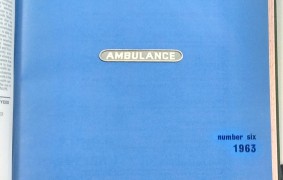
Cover of the National Union of Public Employees' Journal, 1963. NUPE (now part of UNISON) organised many of Britain's ambulance drivers (depicted here as floating heads).
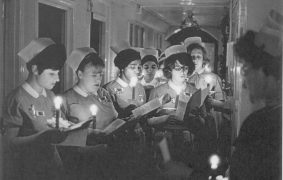
This image, taken at Savernake Hospital, Wiltshire in 1967, reflects a long tradition of Christmas carol singing on hospital wards.
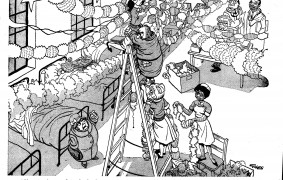
Giles' cartoons often focused on inpatient hospital wards and particularly the interactions between patients and nurses. Despite the vast majority of NHS encounters taking place in GP surgeries, hospitals often dominate imaginary depictions and popular memories of the NHS. Giles' 1963 hospital scene has a lot of interesting features, most notably the way race, gender and class are being shown.…
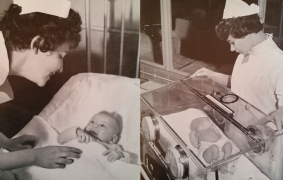
Nursing schools made training with patients a prominent feature in their prospectuses, and especially drew attention to the photogenic care of infants. St George's Hospital (left): "Learning how to care for children has an important place in the curriculum; and there is a post-registration course in paediatrics for those who wish to specialize in this branch of nursing." Guy's Hospital…
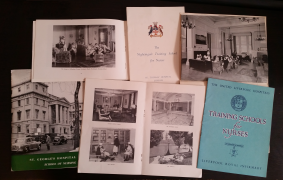
When looking at nursing schools in the 1960s, these were the prospectuses Anna received in the post to show her what the course and life would be like at each hospital.
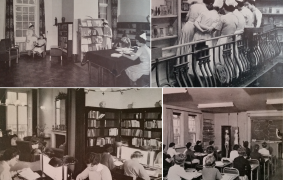
Nursing school prospectuses were keen to show the study and training of nurses, though there was a striking difference in appearance between study at Guy's Hospital (top) and St George's (bottom).

Oesophageal stent donated to the Royal College of Physicians by RCP president-elect (2018) Andrew ‘Bod’ Goddard. Stents like these are used in the treatment of cancer, helping to ensure that tumours don’t block the food pipe. Originally invented in the 1880s, this type of plastic model was introduced in the 1970s. However, the plastic stents were difficult to place –…
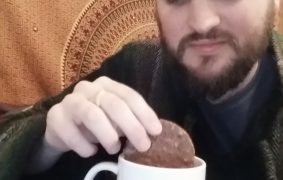
Our researcher George Gosling having tea and biscuits from a Born in the NHS mug
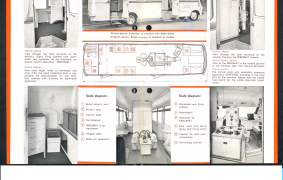
Pamphlet detailing the Mass Miniature Radiographic Unit, manufactured by Siemens, dating from the mid-Twentieth Century. The pamphlet shows the floor plan and a variety of internal pictures of the Unit to show the suitable arrangement of the Unit. Presumably produced as part of the advertising output of Siemens for this unit, the pamphlet provides the viewer today with a visual…

The size of patient record cards has grown over time - from A5 to A4. More and more information has also been added to the patient record envelopes - including images from new technologies such as x-rays and CT scans. GPs have had to shape their surgeries accordingly, making space for these records. With the transition from paper to electronic…
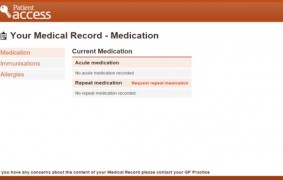
By 2016, GP surgeries had the facilities to enable 96% of patients to view their Summary Care Records online, like this. Summary Care Records contain very basic patient information about medication, allergies and adverse reactions. Patient uptake of this service has been very low sofar though, as only 0.4% of patients have viewed these records online.
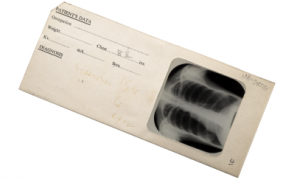
Patient X-Ray cards were an important visual and material object of the attendance at the Mobile Unit. Patients would fill out their details on the card and after their X-Ray was taken, this same card would hold the miniature image.
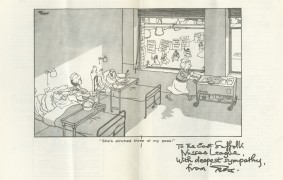
Food has always been a big part of popular ideas about the NHS. The nurse in this cartoon is hungry enough to start stealing the patients' peas because in 1969 the NHS cut her food allowance. As a student nurse living in the hospital her actual pay packet would've been pretty meagre, with bed and board a substantial part of…
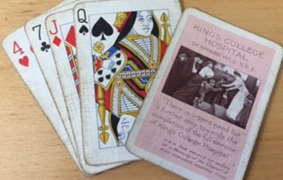
This set of playing cards was recently donated to our archive by a member of the public. Little is known about the origin of the cards but it is likely that they were created as part of a campaign to raise money to fund the relocation of King’s College Hospital from The Strand to Denmark Hill in Camberwell. The move…
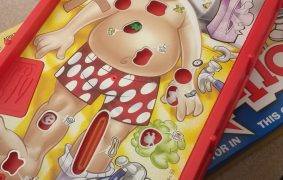
The game Operation was invented in 1964 and remains popular today. Through this game, children are taught about the wonders and challenges of surgical medicine as they improve their dexterity. The game was invented in America, and does not allude to the NHS specifically, although younger guests at our Roadshows have said that they've been inspired to become NHS staff…
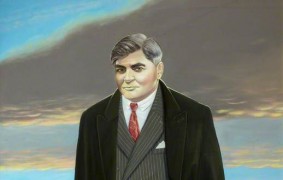
A more recent portrait of Nye Bevan from 1998, painted 50 years after the introduction of the NHS.
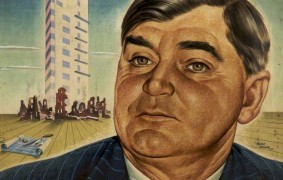
An early painting of Nye Bevan, produced in 1945. The building in the background may be Park Hospital in Trafford , Manchester; the first NHS hospital officially opened by Bevan in 1948. But it may also represent Bevan's work on housing reform. The trowel in the background, as such, may represent the laying of new foundations for the hospital, for…
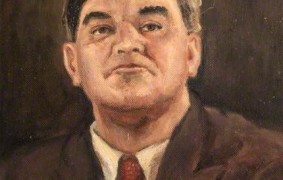
This oil on board painting was produced in 1942, six years before the establishment of the NHS. The realist mode of depiction, sombre colours used and inclusion of a glass of beer help portray Bevan as an 'everyday' man of the people. The image was probably taken from a newspaper or magazine image of Bevan.

My name is Veriline Vassell. I was born in 1930, Springfield, in the parish of St. Elizabeth, Jamaica. My father was a farmer but I answered the call for nurses by the United Kingdom and flew to England in the early 1960s. I rented rooms in a house in Wolverhampton owned by cousins who had arrived in England years earlier. …
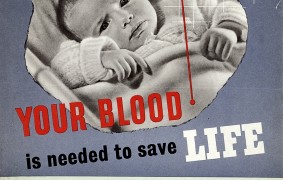
Featured in the Encouraging Blood Donation gallery. Designed by Eileen Evans for the Ministry of Health by the Central Office of Information, this poster continues to utilise the image of the sick child to encourage blood donations. It includes a black-and-white photograph of a sick infant in a hospital bed to create both urgency and sense of realism within the…
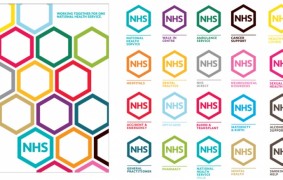
Does the NHS logo serve its purpose? Leading graphic designer Andy Lawrence recently explored the possibility of a rebranding involving using of multi-coloured hexagons. He suggested that the reintroduction of the full name of the National Health Service could have more positive connotations. The use of multiple colours and of interlocking hexagons could be helpful to the users of the…
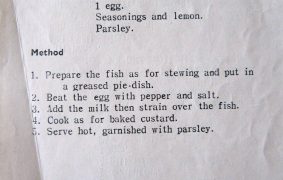
This is a recipe for fish custard; hospital food offered by the Royal Infirmary of Edinburgh Dietetic Department - the first such department in the UK! Have you ever been served such a dish??
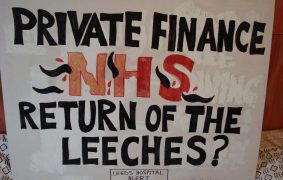
This campaign banner asks whether privatisation in the NHS will in fact reverse care towards an era in which leeches were a popular form of treatment. Ideas about the history of the NHS, and particular the institution's 'founding principles', regularly appear in contemporary campaigning.

Another poster created by Reginald Mount for the Ministry of Health by the Central Office of Information, this focuses on the importance of hand washing for preventing the spread of food-borne illnesses. Encouraging good hygiene practices were still considered a key element in the management of public health at a national level.
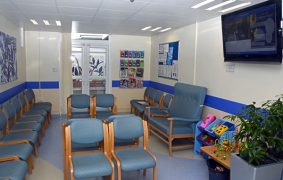
I've chosen this specific photo of an NHS waiting room - a connected row of blue chairs on a blue floor - as this is what comes to mind when I think of an NHS waiting room. Michael Rose
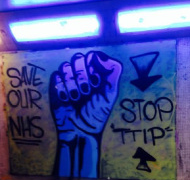
Graffiti in the 'bear pit' underpass in the centre of Bristol used the rallying cry of the NHS in opposition to the controversial Transatlantic Trade and Investment Partnership.
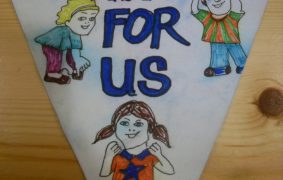
The idea of saving a service or even ideal 'for the children' has been popular in campaigning and political rhetoric since the nineteenth century. This idea assumes particular significance in relation to the NHS, under whose care the vast majority of British children were born.
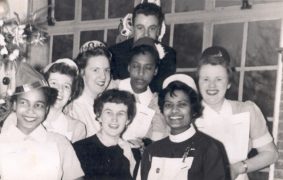
This lovely 1958 photo of Christmas carol singing at Savernake Hospital highlights the long-standing diversity of NHS workers.
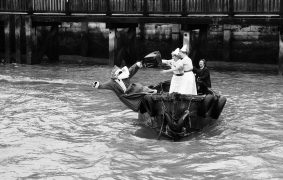
Father Christmas, on his way to a fundraising party for the 'Save Tadworth Hospital' campaign on the 15th of December 1982, slipped from the launch taking him to a luxury yacht where the party was held. He was rescued by nurses from the hospital. Tadworth Court Hospital, then part of the Great Ormond Street Hospital group, was a cottage hospital…
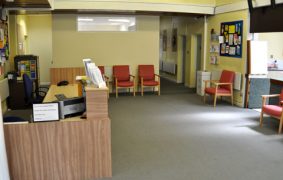
Abortion/sexual health clinic waiting room - the literature on tables e.g. women’s magazines juxtaposed w/ sexual health leaflets. This article led me towards this idea: https://www.theguardian.com/lifeandstyle/2016/apr/16/a-letter-to-my-mother-who-doesnt-know-about-my-abortion Hannah Neary
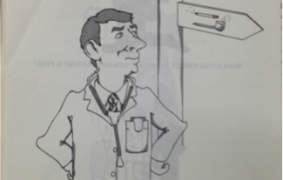
Advice Leaflet outlining where hospital smoking was allowed. Portsmouth and South East Hampshire Health District, c. 1979. (Photographed by Jane Hand from an original in The National Archives)
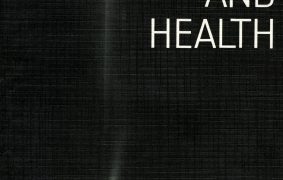
Smoking and Health report, published 1962 In 1962 the Royal College of Physicians published a landmark report on the dangers of smoking tobacco, titled Smoking and health. The publication marked a new era for medicine, public health and the role of the Royal College of Physicians. The report was a huge success, selling out its first print run of 10,000 copies…

Health Education Authority Poster aimed at reducing workplace smoking, c. 1987 (Science Museum, https://www.sciencemuseum.org.uk/broughttolife/objects/display.aspx?id=93452)
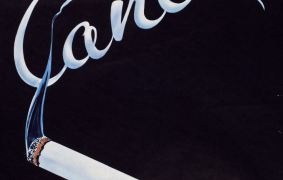
Central Council for Health Education Anti-Smoking Poster c. 1957 (Science Museum, https://www.sciencemuseum.org.uk/broughttolife/objects/display.aspx?id=93442)
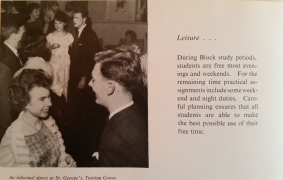
Nursing school prospectuses made an effort to show the social life of student nurses, as well as their training. St George's Hospital highlighted their professional swimming and tennis coaches, as well as hockey, netball and squash facilities, and informal dances. "Careful planning", they said, "ensures that all students are able to make the best possible use of their free time."
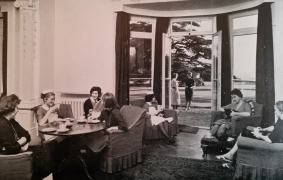
Prospectuses were keen to show the facilities for nursing students, such as the Nurses' Residence at the Atkinson Morley's Hospital for the St George's nursing students.
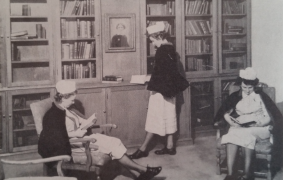
A nursing school prospectus would often show off duty nurses in the library, such as this one for the Nightingale Traingin School as St Thomas' Hospital.
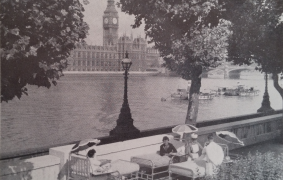
The nursing school at St Thomas understandably drew attention to their location with this photograph of patients overlooking the Thames from their beds on the terrace.
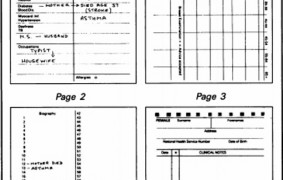
In 1986, an article in the Journal of the Royal College of GPs wrote that: 'It has been said that the key to good general practice is good record keeping'. With this in mind, the article's authors proposed that the above card was used to record and store all patients' records, in a uniform and comparable fashion.

This donated image was received on 4 February 2016. We would welcome further images and thoughts from members of the public to help cast light on the history and emotional and political significance of this idea of being born in the NHS.
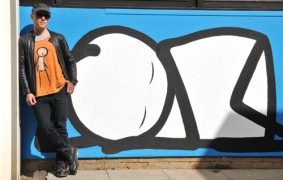
The growing popularity of street art has led to the use of graffiti for hospital fundraising purposes. The artist Stik's iconic work is associated with areas in East London where he used to sleep rough, and he has auctioned pieces of his work to raise funds for local causes. In the autumn of 2015 he produced limited edition copies of…
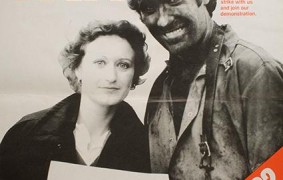
A poster by the National Union of Public Employees, encouraging trade unionists from other industries to support nurses on strike in 1982. During the campaign miners, printers and electricians all went on "solidarity strike" in solidarity with the nurses.
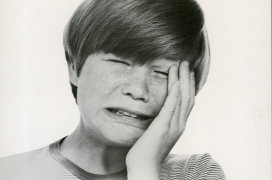
This poster supports fluoridation of water as a public health measure to prevent tooth ache, extractions and fillings. It was produced by the Health Education Council in the 1970s. It was part of a wider debate over fluoridation and concerns about mass medication within British public health.

A selling point for nursing schools was their swimming pools, as shown here in the prospectuses for St George's (left) and St Bartholomew's (right).

Produced by the NHS to combat this Swine Flu pandemic of 2009-2010, this poster returns to the immediate postwar focus on the catching germs in a tissue. It follows a similar pattern in both showing and telling how the need to prevent germs from spreading is a matter of individual responsibility. It combines a new 'catch it, bin it, kill…
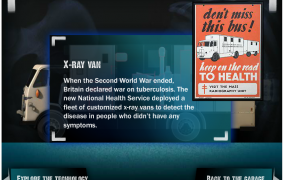
Created by the Science Museum Brought to Life tool, this interactive 'tour' allows you to explore a Mass Miniature Radiography Unit as it would have looked in the 1940s and 1950s. It enables users to read pop-up information screens about the name of the service, the types of vans used, the necessity that the vans be climate-controlled as well as…
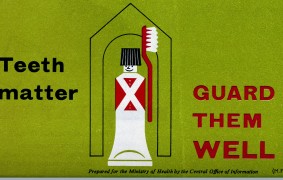
This poster was part of a broader campaign aimed at encouraging correct teeth brushing amongst children. It shows a tube of toothpaste and a toothbrush in a sentry box, emphasising the need to guard teeth against plaque and cavities. Produced by the Central Office of Information on behalf of the Ministry of Health, c. 1960.
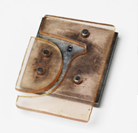
Template (JIG) for making child's spectacles; British, 1960-85. Museum no. B.316-1996
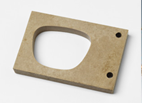
Template for making child's spectacles; British, 1960-85. Museum no. B.314-1996

Template for making child's spectacles; British, 1960-85. Museum no. B.315-1996
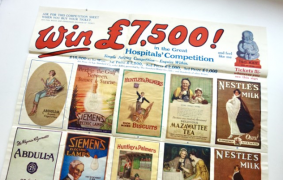
During the 1920s the Fund continued to raise money to support the voluntary hospitals by launching the ‘Combined Hospital Appeal’. The cause was widely promoted at the time to encourage people to give to the hospitals. One such awareness-raising campaign was a poster competition that asked for members of the public to design posters based on the theme ‘Save our…
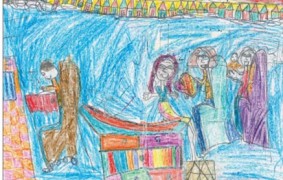
This drawing was made by a seven year old girl. Depicting her visit to a doctors, she portrays herself on the examining table, and the doctor with his back to her, staring at his computer. An article in the Journal of the American Medical Association used this to illustrate concerns about how technology can lead doctors to lose the personal…
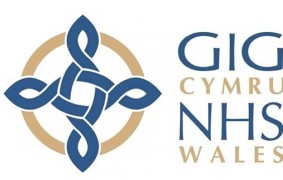
Although the blue lozenge symbol became ever-present in England's NHS, differences throughout the period in Northern Ireland and the process of devolution in Wales and in Scotland saw the emergence of distinctive services with their own logos, and their own strict guidelines on the use of this branding.
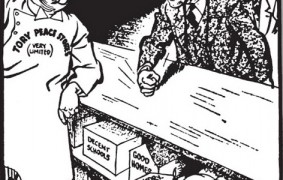
The lukewarm Conservative response to Beveridge's groundbreaking report triggered anger among many voters, who felt they had already paid - through wartime sacrifices - for a Welfare State, including, as this 1945 Philip Zec cartoon illustrates, 'proper medical attention'. The cartoon, originally published in the left-leaning Daily Mirror newspaper, was later re-used in a 1945 Labour campaign leaflet.
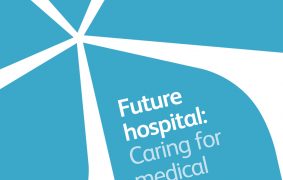
Future hospital: caring for medical patients: A report from the Future Hospital Commission to the Royal College of Physicians, published September 2013 The Future Hospital Commission (FHC), chaired by Professor Sir Michael Rawlins, was established by the Royal College of Physicians in 2012 to address growing concerns about the standards of care currently seen in hospitals, and to make recommendations for providing patients…
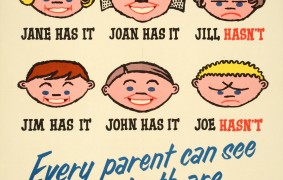
This poster was part of a broad dental hygiene campaign organised by the Ministry of Health to reduce the rates of childhood dental caries during the 1950s and 1960s. The end of rationing in 1954 had brought about a massive increase in sugar consumption and as a result there was a huge rise in the number of cavities present in…
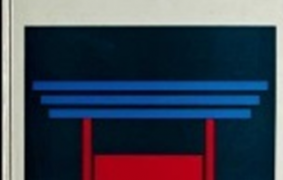
In 1967, this report, carried out by a King's Fund Working Party, looked at hospital bedsteads with a view to improving their design. The resulting specification, or ‘The King’s Fund bed’, produced a standardised design which was more comfortable for patients and easier for nurses to use. The new design used pedals to adjust the height, a reclining back-rest and…
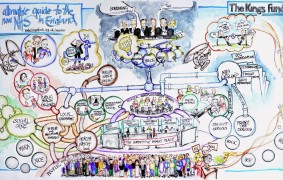
Produced by the health think tank, the King's Fund, this image seeks to humanise the complex reorganisation of the English NHS required by the 2012 Health and Social Care Act. See the King's Fund's video of the production of this organisational chart here.
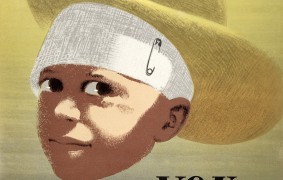
Featured in the Encouraging Blood Donation gallery. This poster was designed by Reginald Mount for the Ministry of Health in the 1950s. It shows a child emulating The Lone Ranger (made famous in the American television show of the same name) complete with stetson hat, to encourage members of the public to donate blood. The focus on children in this…

Fundraising continued into the 1930s. This pamphlet is a photocopy of the programme for the `Miniature Hospital' exhibition in 1933. The King’s Fund Propaganda Committee commissioned a scale model of a modern hospital, including a children’s ward, an operating theatre and a working lift. The Committee hoped that the model would result in a more general understanding of a hospital’s…
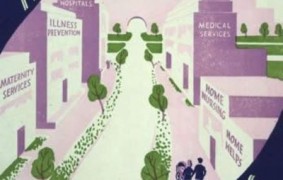
Produced by the City of Wakefield, this leaflet introduced the new NHS to local users.
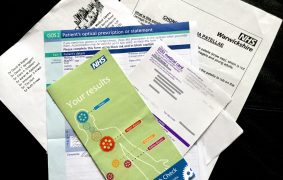
At first, as a reasonably healthy middle-aged person, I was not sure I would FIND much of the NHS in my home. How wrong I was: here's just a sample of the paper traces I saw when I actually looked-- advice, forms, pamphlets and medical card...

At first, as a reasonably healthy middle-aged person, I was not sure I would FIND much of the NHS in my home. How wrong I was: here's just a sample of the paper traces I saw when I actually looked-- advice, forms, pamphlets and medical card...
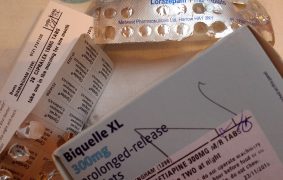
"A myriad of meds from a very attentive GP and hard-working psychiatrist!"
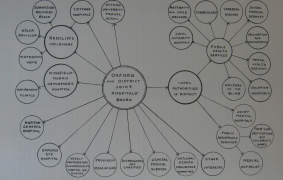
Featured in the Pre-NHS Healthcare Reforms gallery. The Oxford model for co-ordinating hospital services, strongly advocated by Lord Nuffield, was widely admired and imitated in the late 1930s.

A present day GP surgery in Derbyshire, filmed for ‘The Real Peak Practice television series, aired on BBC One in July 2015. For clips see: https://www.bbc.co.uk/programmes/p02xny8x.
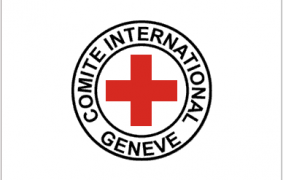
Images of the NHS before the 1990s suggest an absence of a universal identifying symbol. Such an absence helps explain why, when the Labour Party produced a campaigning poster attacking Conservative spending on the NHS in 1988, they represented this through a red cross symbol overlaid on a £ sign. The use of the red cross symbol for political purposes…
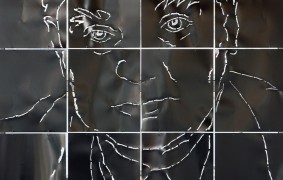
This tinplate image of Nye Bevan is by the artist Dylan Hammond, and was displayed for 3 months in the Welsh Assembly in Cardiff in 2008. The image was surrounded by controversy due to also being displayed alongside another tinplate image by the artist of Margaret Thatcher.
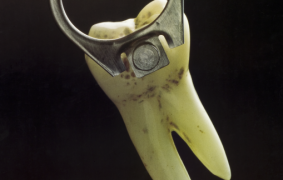
This poster was also produced as part of a 1992 dental health campaign by the Health Education Authority. This poster focused on the sugar content of fizzy drinks and their impact on tooth decay. The combination of the can ring and an extracted tooth aimed to visually connect the impact of high sugar consumption on the health of teeth.

This poster was produced by the Health Education Authority in 1992. It explained the role consumption of sweets and sugar play in tooth decay. It emphasised that half of all children under the age of 5 had evidence of tooth decay.
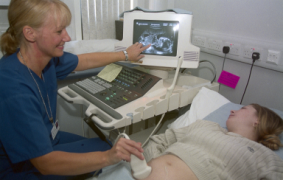
Ultrasound is a form of diagnostic image technology routinely used to scan images of the foetus within the womb to monitor the growth and development of the baby. It has been routinely used in hospitals as a standard component of maternity care since the 1970s.
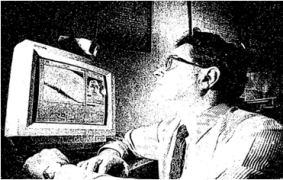
The space of GP surgeries was significantly changed by the introduction of new communication technologies, such as computers and video-conferencing. In this image Dr Keith Freeman, a dermatologist, uses video-conferencing to diagnose patients from eight GP surgeries in mid-Wales.
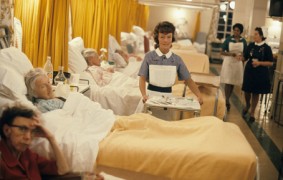
Photograph of ward mealtime at unknown hospital, c. 1970s. (Image copied by Jane Hand from an original in the National Archives)
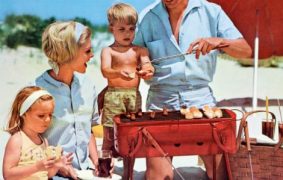
Prepared for the Scottish Home and Health Department by the Central Office of Information (the state body responsible for public information campaigns), this poster was designed by graphic designer, Reginald Mount as part of a broader campaign focused on food poisoning prevention and the betterment of food hygiene practices, especially on holiday.
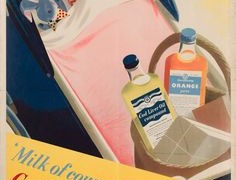
Poster for the Welfare foods programme (which entitled all infants and expectant mothers to free milk, orange juice and cod liver oil) c. 1950. (Image reproduced by the National Archives for Jane Hand via their Image Library reproduction service).

Cover of Which? Magazine 1975 which asks ‘How well does the NHS work?’ and includes food as one major factor is assessing this. (Photographed by Jane Hand from the original in the English Museum of Rural Life)
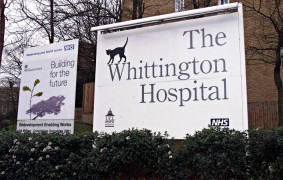
The Whittington Hospital in North London provides an example of a hospital clinging on to its own logo - Dick Whittington's black cat - alongside the new NHS branding. We are interested in tracing the extent to which this was a more general phenomenon and the politics of such a dual identity.
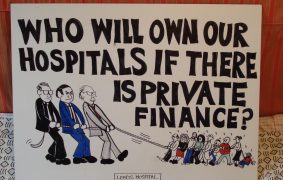
Hospitals, rather than GP surgeries or community care, are often the focus of NHS-related campaigning. This placard again presents the idea of hospitals as 'ours', belonging to the community or society.
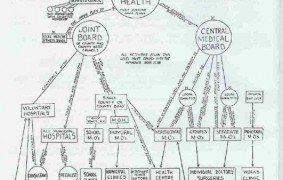
Diagram of the post-war health services as proposed by Conservative Minster for Health Henry Willink's White Paper of 1944, poduced by the Medical Practitioner's Union. Courtesy, Socialist Health Association. See the MPU's scathing critique here.
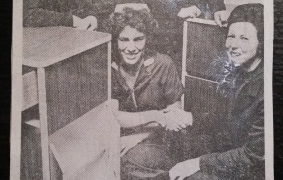
Coverage in the Bristol Evening Post of a WRVS donation of twelve patients lockers at the Bristol Royal Infirmary (c.1972-78). Image kindly donated by Hilary Macaulay.
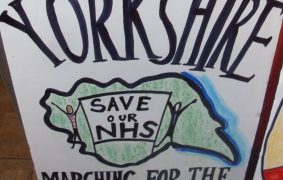
This placard demonstrates concern about both Yorkshire's NHS, but also 'our NHS' more broadly. Such entwining of concerns for the NHS on a local and a national level is common among campaigners, who often meet both to defend local services, but also because of anxieties about what changes in their area mean for the broader work and culture of the…
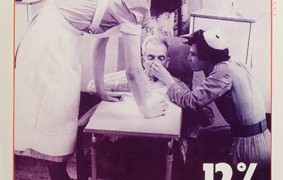
National Union of Public Employees pay campaign poster, 1982. The slogan, "you can't live on dedication", had a long history on nurses' pay protest and was used in various forms during other pay disputes including 1962, 1973 and 1979.
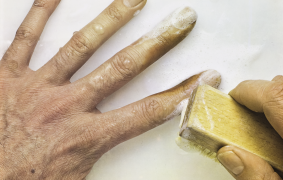
Health Education Council Poster designed by Saatchi and Saatchi, c. late 1970s (Science Museum,https://www.sciencemuseum.org.uk/broughttolife/objects/display.aspx?id=93440 )
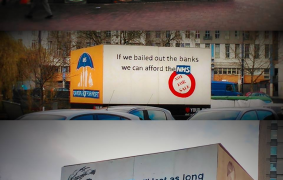
These graffiti boards greeted arrivals in Bristol at the end of the M32 in late 2014, rising up from the Bearpit where the bohemian Stokes Croft area meets the city centre. Here the NHS's folk history is used to provide both legitimacy and inspiration for the politics of NHS protest.


